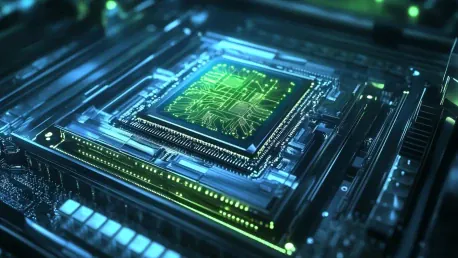In recent years, the AI hardware market has been dominated by NVIDIA, a company renowned for its advanced GPUs that power a myriad of AI applications. However, the competitive landscape is shifting dramatically as AMD and Intel ramp up their efforts to challenge NVIDIA’s supremacy in this booming industry. The second week of October 2024 witnessed significant announcements from both AMD and Intel, with each company unveiling a slew of cutting-edge products and strategic directions aimed directly at capturing a larger share of the AI hardware market.
Recent Announcements and Product Launches
Both AMD and Intel have showcased their commitment to AI and high-performance computing (HPC) with several groundbreaking product launches that aim to transform the landscape. Intel’s latest offerings include the new Xeon 6 processors featuring Performance-cores (P-cores) designed to significantly boost performance for AI and HPC applications. These processors come with promises of substantial improvements, specifically tailored to meet the needs of rigorous computational tasks.
In addition to the Xeon 6 processors, Intel unveiled its Gaudi 3 AI accelerators, which claim to offer up to 20 percent more throughput and double the price/performance ratio compared to NVIDIA’s #00 for the inference of LLaMa 2 70B models. This strategic move highlights Intel’s aggressive approach to capturing market share by providing superior performance at a competitive cost. Moreover, Intel announced the rebranding of its Intel Tiber Developer Cloud to Intel Tiber AI Cloud, emphasizing a platform designed to accelerate AI development using Intel-optimized software and the latest processors.
On the other side of the competition, AMD introduced an impressive range of new products, including the AI PRO 300 Series processors, AMD Instinct MI325X accelerators, and 5th Gen AMD EPYC CPUs. These innovations underline AMD’s dedication to meeting the growing demands within data centers and AI applications, setting the stage for vigorous competition with Intel and NVIDIA. AMD has emphasized its strategy of building momentum for its EPYC and Instinct processors to leverage significant growth opportunities in the AI sector.
Strategic Events and Conferences
The product unveilings from AMD and Intel were accompanied by significant events that served as platforms to highlight their advancements. Intel kicked off its fourth annual AI Global Impact Festival, a pivotal event that brings together industry experts and stakeholders to discuss the company’s latest innovations and broader ecosystem contributions in AI. This festival was an opportune moment for Intel to display its new products and outline its vision for future strategic directions.
Simultaneously, AMD was making waves with its Advancing AI 2024 conference, an event focused on showcasing the company’s technological innovations and strategic plans for the AI hardware industry. This conference provided insights into AMD’s future direction regarding AI accelerators and the continually expanding capabilities of data centers. By hosting such a significant event, AMD reinforced its commitment to leading the AI revolution and its readiness to compete at the highest levels of the industry.
Focus on Open Ecosystem and Development
Open ecosystems and collaborative innovation have become critical themes for both AMD and Intel as they navigate the competitive terrain. Intel’s rebranding of its Intel Tiber Developer Cloud to Intel Tiber AI Cloud reflects this strategic focus. By offering a dedicated, scalable, and open-source-compliant cloud infrastructure for AI development, Intel aims to provide a comprehensive environment that integrates various components across silicon, systems, software, and services. This initiative seeks to facilitate a seamless and holistic experience for AI research and practical application.
Similarly, AMD has showcased significant efforts to expand its open-source AI software ecosystem. By emphasizing openness and collaboration, AMD aims to create a more inclusive and flexible environment that fosters AI development and addresses diverse computational needs. This strategic focus on open ecosystems is not merely about technology but also about community and partnership, as both companies aim to build supportive networks that drive innovation forward.
Performance and Efficiency Improvements
In the realm of technical innovations, both AMD and Intel are keenly focused on delivering products that offer unparalleled performance and efficiency, crucial for meeting the emerging demands of AI and HPC workloads. Intel’s Xeon 6 processors with new P-cores and Gaudi 3 AI accelerators are designed to meet the rigorous requirements of these workloads, promising enhanced computational power and energy efficiency. These advancements are essential for industries that need high-performance computing solutions.
AMD is matching Intel stride for stride. The latest EPYC CPUs and Instinct GPUs from AMD are engineered to target significant performance improvements while maintaining energy efficiency. These processors and accelerators are built to handle the most challenging workloads, ensuring that AMD stays competitive in the high-stakes AI hardware sector. Such innovations are vital for sustaining the intense computational needs of modern AI applications.
Growth Projections and Market Dynamics
The AI hardware market is on the verge of massive growth, providing extensive opportunities for companies that are investing in advanced technologies. AMD’s CEO, Dr. Lisa Su, has projected that the accelerator market could grow to an astounding $500 billion by 2028. This incredible growth potential presents ample room for both AMD and Intel to make substantial inroads even as they compete against the established market leader, NVIDIA.
This fierce competition between AMD and Intel is characterized by relentless innovation and strategic initiatives. Both companies are pushing the envelope continuously, offering products that not only meet current demands but also anticipate the future needs of the industry. The ongoing battle is not just about hardware but also encompasses software, ecosystem support, and long-term strategic vision.
Trends and Future Directions
The ongoing innovations and strategic efforts by AMD and Intel highlight several key trends that are shaping the AI hardware market. There is a notable focus on integrating more specialized cores and accelerators tailored specifically for AI and HPC workloads. Additionally, the emphasis on cloud-native solutions indicates a broader industry shift towards more flexible and collaborative models of innovation. Both companies are driving these trends forward with their aggressive development roadmaps, suggesting that their rivalry will intensify further.
Looking ahead, the competition between AMD, Intel, and NVIDIA underscores a broader trend towards accelerating AI development through advanced hardware solutions. With each company leveraging its unique strengths and innovations, the forthcoming years promise considerable advancements in AI hardware. These advancements will not only push the boundaries of performance but will also refine power efficiency and enhance support for broader software ecosystems.
Summary
In recent years, NVIDIA has enjoyed a dominant position in the AI hardware market, thanks to their highly advanced GPUs, fueling a wide array of AI-driven applications. However, this once unchallenged reign is now facing stiff competition. Both AMD and Intel have significantly turned up the heat, striving to claim a stake in this ever-expanding sector. During the second week of October 2024, both tech giants made notable announcements, rolling out a series of groundbreaking products and outlining new strategies explicitly designed to disrupt NVIDIA’s stronghold.
AMD, known for its high-performance processors, showcased its latest innovations that promise to rival NVIDIA’s offerings. Their new hardware aims to deliver exceptional performance and efficiency, crucial for AI tasks. Intel, on the other hand, has leveraged its extensive expertise in semiconductor technology to introduce a lineup of AI-focused chips. These developments signaled Intel’s commitment to stepping up its game in this competitive field.
The unveiling of these products is more than just a tech showcase; it marks a pivotal shift in the AI hardware market. With AMD and Intel making such aggressive moves, the landscape is set to become more competitive, ultimately fostering innovation and benefiting end-users. The AI hardware arena, once dominated by a single player, now promises more diversity and rapid advancements, as these companies vie for leadership.









